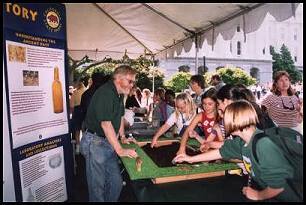Old SACRF Text from Content Pages
Budding Archaeologists Practice Their Techniques at "Take Your Child/Mentee to Work" Day.
As part of the Resources Agency annual Take Your Child/Mentee to Work Day, the Cultural Resources Division of California State Parks put on a "dig" for the children. Archaeologists Glenn Farris and Aimee Hayes from CRD were on hand to help guide the efforts. After enduring a brief explanation of how and why professional archaeologists go about the business of scientific investigation, the kids launched into an excavation of a 50 cm by 1 meter unit that featured artifacts ranging from prehistoric to early 20th century. In the process they unearthed such items as a hammerstone used by California Indians; early 19th century ceramics representing English trade to California during the mission period; a silver "piece of eight" from the late 18th Century; and such other items as marbles, a toy train engine, a bottle from the mid 19th Century and cut nails. Two pieces of an early 19th century chamber pot were found, though when the use of a chamber pot was shared with the assembled company, a few "Eww!s" and "Gross’s" were heard. Other activities included a brief introduction to the metric system with the kids learning their heights in centimeters and the use of some graphics to introduce the kids to the State Park system as well as the geography of California.
A good, if hectic, time was had by all. Our appreciation to Maureen O’Connor for her great efforts in organizing the event.



Robert Leavitt is a graduate student in anthropology, with an emphasis on historical archeology, at the University of Nevada, Reno. He recently visited the California State Archaeological Collections Research Facility as a source of data for his MA thesis.
small.jpg)
small.jpg)
small.jpg)
.jpg)
.jpg)
.jpg)
